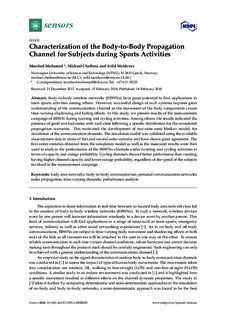| dc.contributor.author | Mohamed, Marshed Kassim | |
| dc.contributor.author | Cheffena, Michael | |
| dc.contributor.author | Moldsvor, Arild | |
| dc.date.accessioned | 2018-02-20T12:16:45Z | |
| dc.date.available | 2018-02-20T12:16:45Z | |
| dc.date.created | 2018-02-18T18:43:52Z | |
| dc.date.issued | 2018 | |
| dc.identifier.citation | Sensors. 2018, . | nb_NO |
| dc.identifier.issn | 1424-8220 | |
| dc.identifier.uri | http://hdl.handle.net/11250/2485983 | |
| dc.description.abstract | Body-to-body wireless networks (BBWNs) have great potential to find applications in team sports activities among others. However, successful design of such systems requires great understanding of the communication channel as the movement of the body components causes time-varying shadowing and fading effects. In this study, we present results of the measurement campaign of BBWN during running and cycling activities. Among others, the results indicated the presence of good and bad states with each state following a specific distribution for the considered propagation scenarios. This motivated the development of two-state semi-Markov model, for simulation of the communication channels. The simulation model was validated using the available measurement data in terms of first and second order statistics and have shown good agreement. The first order statistics obtained from the simulation model as well as the measured results were then used to analyze the performance of the BBWNs channels under running and cycling activities in terms of capacity and outage probability. Cycling channels showed better performance than running, having higher channel capacity and lower outage probability, regardless of the speed of the subjects involved in the measurement campaign. | nb_NO |
| dc.language.iso | eng | nb_NO |
| dc.publisher | MDPI | nb_NO |
| dc.rights | Navngivelse 4.0 Internasjonal | * |
| dc.rights.uri | http://creativecommons.org/licenses/by/4.0/deed.no | * |
| dc.title | Characterization of the Body-to-Body Propagation Channel for Subjects during Sports Activities | nb_NO |
| dc.type | Journal article | nb_NO |
| dc.type | Peer reviewed | nb_NO |
| dc.description.version | publishedVersion | nb_NO |
| dc.source.pagenumber | 14 | nb_NO |
| dc.source.volume | 18 | nb_NO |
| dc.source.journal | Sensors | nb_NO |
| dc.source.issue | 2 | nb_NO |
| dc.identifier.doi | 10.3390/s18020620 | |
| dc.identifier.cristin | 1566396 | |
| dc.description.localcode | (c) 2018 by the authors. Licensee MDPI, Basel, Switzerland. This article is an open access article distributed under the terms and conditions of the Creative Commons Attribution (CC BY) license (http://creativecommons.org/licenses/by/4.0/). | nb_NO |
| cristin.unitcode | 194,64,94,0 | |
| cristin.unitcode | 194,63,35,0 | |
| cristin.unitname | Institutt for vareproduksjon og byggteknikk | |
| cristin.unitname | Institutt for elektroniske systemer | |
| cristin.ispublished | true | |
| cristin.fulltext | original | |
| cristin.qualitycode | 1 | |

